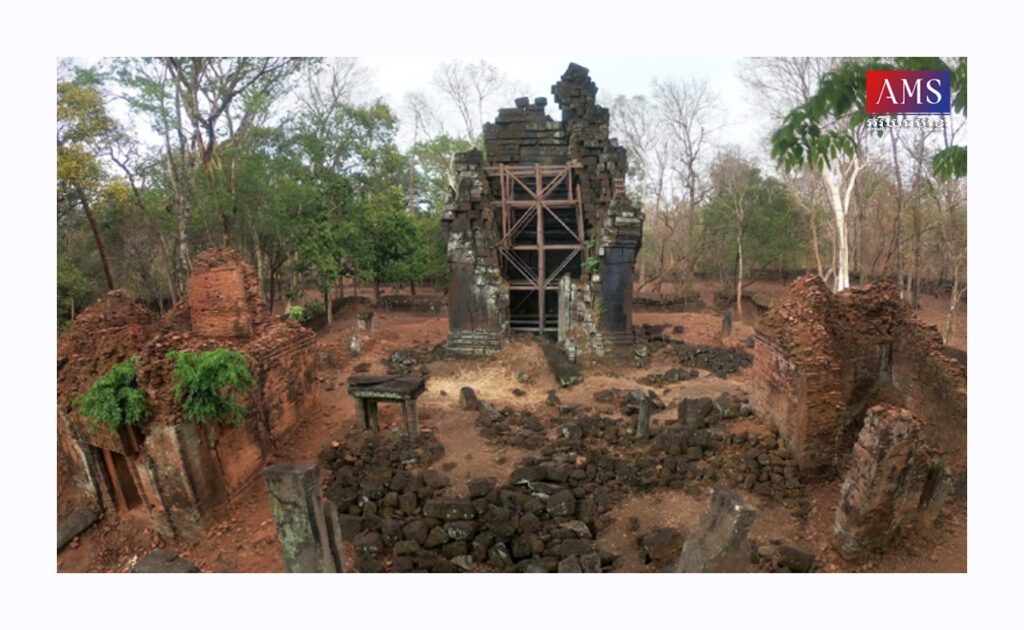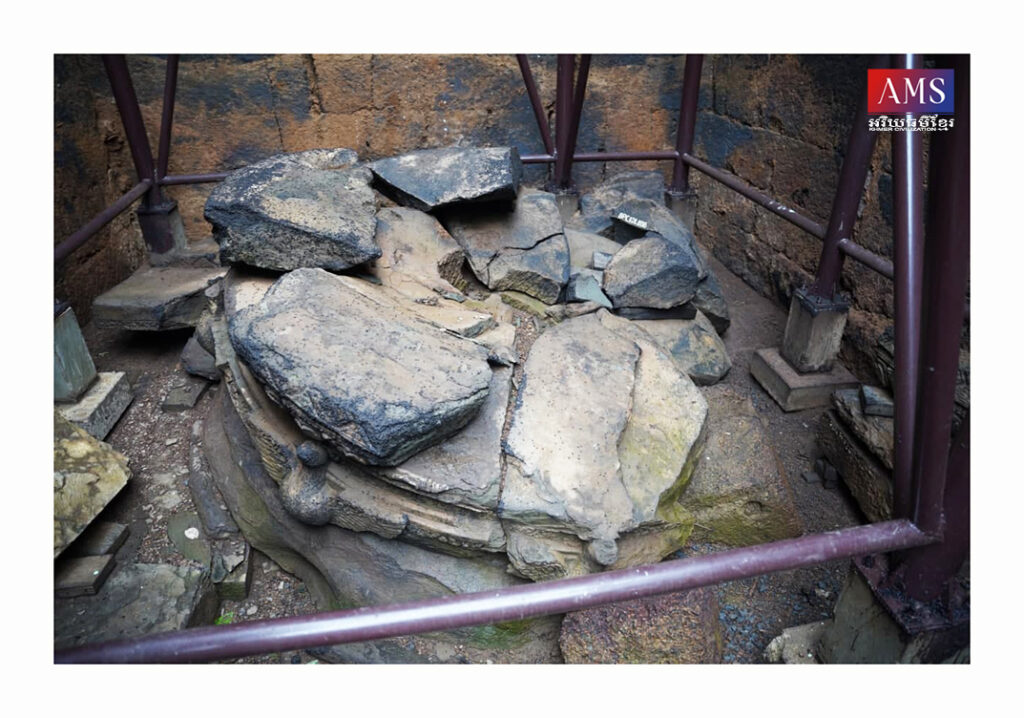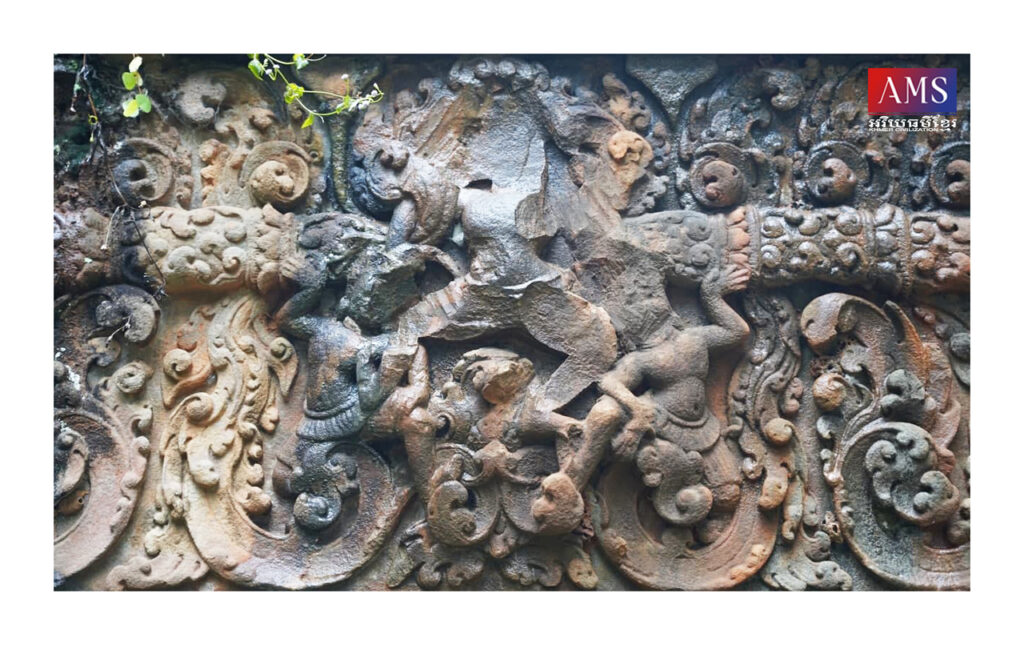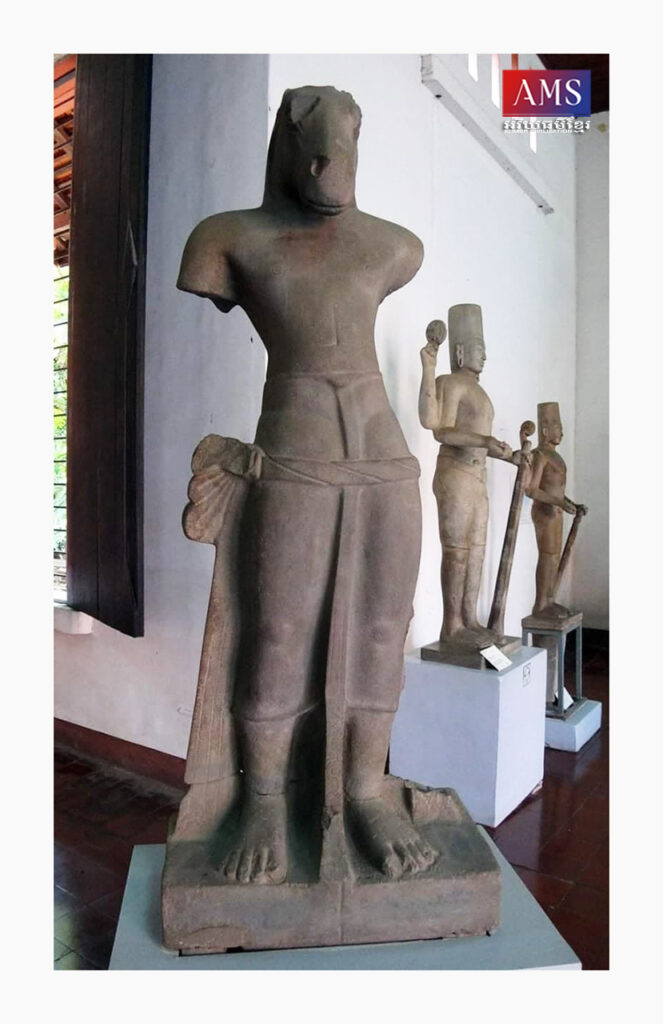វជីមុខ(Vajimukha) មានន័យថាមានព្រះកេសជាសេះ និងដងខ្លួនជាមនុស្ស។ ទេពវជីមុខ គឺជាអវតាទី១០របស់ព្រះវិស្ណុ ហើយទ្រង់ជាអ្នកបំផ្លាញសភាវអាក្រក់ និងរក្សាគម្ពីវេទ។ ចម្លាក់ទេពវជីមុខ បន្តគោរពនៅក្នុងសិល្បៈខ្មែរតាំងពីមុនសម័យអង្គរក្នុងសតវត្សទី៧នៃគ.សមក។ រហូតមានចម្លាក់រូបវជីមុខ និងមធុកៃតភ(Madhu-Kaitabha) បង្ហាញនៅផ្តែរប្រាសាទបន្ទាយពីរជាន់ ដែលបង្ហាញជារូបសម្លាប់បិសាចពីរនាក់បងប្អូនគឺមធុ និងកៃតភ។ ចម្លាក់រឿងវជីមុខ និងមធុកៃតភបង្ហាញការឆ្លាក់នៅប្រាសាទបន្ទាយពីរជាន់នេះ គឺឆ្លាក់រឿង និងរូបព្រះវិស្ណុ ដែលទាក់ទងនឹងការរក្សាគម្ពីវេទរបស់ព្រះព្រហ្ម ដែលមានប្រាង្គកណ្តាលប្រាសាទដង្កល់រូបព្រះព្រហ្មដ៏ធំ។ ដោយសារបិសាចទាំងពីរមធុ និងកែតភបានលួចគម្ពីរបស់ព្រះព្រហ្ម នៅពេលដែលព្រះអង្គអង្គុយសមាធិក។ ខាងក្រោមនេះនឹងបង្ហាញរឿងទេវកថាមធុកៃតភក្នុងអត្ថបទសាច់រឿងពីរស្រដៀងគ្នានៅឥណ្ឌា និងយកមកបង្ហាញប្រៀបធៀបនឹងសិល្បៈខ្មែរតាំងពីសតវត្សទី៧នៃគ.សមក។ អត្ថបទនេះនឹងបង្ហាញប្រៀបធៀបចម្លាក់ទោល២មុនសម័យអង្គរ និងសម័យសតវត្សទី១០នៃគ.សក្នុងរាជព្រះបាទជ័យវរ្ម័នទី៤ប៉ុណ្ណោះ។


រឿងវជីមុខ និងមធុកៃតភសរសេរជាភាសារសឹស្រ្កឹត គឺនិយាយពីទេវអាក្រក់(បិសាច)នៅក្នុងសំណេរព្រហ្មញ្ញាសាសនា។ មធុ និងកៃតភនេះកើតចេញពីក្អែលត្រជៀករបស់ព្រះវិស្ណុ នៅពេលដែលព្រះអង្គអង្គុយសមាធិ។ ទេពកើតចេញពីផ្ចិតរបស់ទ្រង់គឺព្រះព្រហ្ម ដែលអង្គុយលើបល្ល័ង្កផ្កាឈូក។ នៅក្នុងគម្ពីភគវតបុរាណបានកត់ត្រាថា ក្នុងកំឡុងពេលបង្កើតលោកគឺមានបិសាចឈ្មោះមធុ និងកៃតភបានលួចយកគម្ពីវេទពីព្រះព្រហ្ម។ ព្រះវិស្ណុក្នុងទម្រង់ជាអវតាជាហយគ្រីវ(Hayagriva) ដែលជាទេពតំណាងអោយចំនេះដឹង និងប្រាជ្ញា ហើយមានខ្លួនជាមនុស្ស និងព្រះកេសជាក្បាលសេះ។ អវតាជាហយគ្រីវ ឬវជីមុខ បានសម្លាប់បិសាចទាំង២នេះរួចនាំយកគម្ពីវេទមកជូនព្រះព្រហ្មវិញ។
សាច់រឿងទេវកថាមានសរសេរពីបិសាចទាំង២ផ្សេងមួយទៀត គឺទាក់ទងនឹងទេពព្រះនាងឧមា។ មធុ និងកៃតភ គឺមានដើមកំណើតមកពីក្អែលត្រជៀកព្រះវិស្ណុនៅពេលបំពេញតបធម៌គោរពដល់ព្រះនាងឧមា។ បិសាចទាំងពីរនាក់មានអាវុធនិងមន្តអាគមន៍ខ្លាំង ហើយបានចាប់ផ្តើមវាយប្រហារព្រះព្រហ្ម។ ព្រះព្រហ្មបានដាសព្រះវិស្ណុដែលកំពុងធ្វើតបធម៌អោយជួយលោក ប៉ុន្តែមិនអាចដាសព្រះព្រហ្មបាន ក៏បួងសួងដល់ព្រះនាងឧមា និងបន្ទាប់មកព្រះនាងជួយដាសព្រះវិស្ណុ។ បិសាចមធុ និងកៃតភបានប្រយុទ្ធជាមួយព្រះវិស្ណុ ហើយព្រះវិស្ណុបានទទួលការផ្តល់យោបល់ពីព្រះនាងឧមា ដើម្បីទៅវាយប្រហារបិសាចទាំងពីរនេះបានជោគជ័យ។
ចំណែកចម្លាក់ផ្តែរមួយ បង្ហាញពីចម្លាក់ព្រះវិស្ណុប្រយុទ្ធជាន់ពីលើបិសាចមធុ និងកៃតភនេះនៅប្រាសាទបន្ទាយពីរជាន់កោះកេរប្រាង្គផ្នែកពាយ័ព្យ និងផ្តែរផ្នែកខាងលិចគឺបង្ហាញចលនាប្រយុទ្ធគ្នាដោយដៃចាប់សក់បិសាចទាំងពីរនាក់។ ប៉ុន្តែប្រាសាទបន្ទាយពីជាន់នេះពុំឧទ្ទិសសំខាន់ទៅព្រះវិស្ណុទេ។ ប្រាសាទនេះមានដង្កល់ទេវរូបព្រះព្រហ្មមួយដ៏ធំនៅប្រាង្គកណ្តាល ដែលបាត់ព្រះកេសនៅសល់តែបល្ល័ង្ក និងបំណែកចង្កេះមួយចំនួន។ ដូច្នេះប្រាសាទបន្ទាយពីជាន់នេះបង្ហាញយ៉ាងច្បាស់ថាទាក់ទងសាច់រឿងដែលមានបង្ហាញក្នុងការសរសេរទាំងពីរនៅផ្នែកខាងលើ។ ឧទារហណ៍ព្រះព្រហ្មជាអ្នកថែរក្សាគម្ពីវេទ ហើយបានលួចដោយបិសាចមធុ និងកៃតភ បន្ទាប់មកព្រះវិស្ណុបានប្រយុទ្ធយកគម្ពីមកជូនព្រះព្រហ្មវិញ។ ចម្លាក់ទោល១ផ្សេងទៀតដែលស្ថិតក្នុងដើមសតវត្សទី១០នៃគ.សដូចគ្នា គឺស្ថិតក្នុងរចនាបថកោះកេរ ដែលនៅប្រាសាទនាងខ្មៅ ស្រុកបាទី ខេត្តកណ្តាល សព្វថ្ងៃនៅសារមន្ទីរជាតិភ្នំពេញ។

ប៉ុន្តែចម្លាក់នេះខ្មែរពេញនិយមឆ្លាក់ជាបដិមាទោលតាំងពីសម័យមុនអង្គរក្នុងដើមសតវត្សទី៧នៃគ.សមក គឺចម្លាក់ទោលវជីមុខរចនាបថភ្នំដាមកពីទួលព្រះគិន នៅគុកទ្រាប ស្រុកកណ្តាលស្ទឹង ខេត្តកណ្តាល សព្វថ្ងៃនៅសារមន្ទីរជាតិ។ បដិមាទោលរូបវជីមុខរចនាបថភ្នំដានេះបង្ហាញចលនារាងទុចចង្កេះ មានសម្លៀកបំពាក់ស្តើង និងមិនមែនពាក់ម្កុតដូចក្នុងរចនាបថកោះកេរទេ។ ចម្លាក់វជីមុខមុនសម័យអង្គរនេះជាចម្លាក់មួយចាស់ដូចបដិមាផ្សេងៗទៀតក្នុងរចនាបថភ្នំដា ដែលទទួលឥទ្ធិពលរចនាបថគុប្តឥណ្ឌាខាងត្បូង។ ចម្លាក់នេះនៅតែពេញនិយមរហូតដល់សម័យក្រោយរចនាបថកោះកេរទៀតគឺក្នុងរចនាបថប្រែរូប។

សរុមសេចក្តីមកចម្លាក់រូបវជីមុខនិងមធុកៃតភមានបង្ហាញជាសាច់រឿងពេញប្រយុទ្ធគ្នាគឺមានតែនៅលើផ្តែរប្រាសាទក្រចាប់កោះកេរទេ ដែលបង្ហាញក្នុងប្រាសាទដែលឧន្ទិសដល់ព្រះព្រហ្មភ្ជាប់ជាមួយនឹងសាច់រឿងនៅលើផ្តែរ។ ជាពិសេសសម័យកាលប្រហែលគ្នាមានការគោរពនៅប្រាសាទនាងខ្មៅស្រុងបាទី និងបន្តក្រោយរចនាបថប្រែរូបផងដែរ។ បើទោះបីមិនសូវមានការឆ្លាក់រូបវជីមុខ និងមធុកៃតភច្រើននៅមុនរាជព្រះបាទជ័យវរ្ម័នទី៤ក្នុងសម័យអង្គរ ក៏មានចម្លាក់ទោលមុនសម័យអង្គរក្នុងសតវត្សទី៧នៃគស ធំមួយដែលបង្ហាញពីការគោរព និងឥទ្ធិពលរឿងមកបង្ហាញក្នុងសិល្បៈខ្មែរដែរ។
——————————————————
Vajimukha and Madhu Kaitabha in Khmer Art
Vajimukha means having a horse-like head and a human body. Vajimukha deity is the tenth incarnation of Vishnu and he is the destroyer of evil and the keeper of the Vedic scriptures. Vajimukha sculpture has been revered in Khmer art since before the Pre-Angkorian period in the 7th century continuing has appeared on Prasat Banteay Pir Chean, which shows the killing of two brothers demon, Madhu and Kaitabha. The carving of Vajimukha and Madhu-Kaitabha at the Prasat Banteay Pir Chean is shown their story and the image of Vishnu related to the preservation of the Vedic scriptures of Brahma, with the central tower of the temple placing a large image of Brahma. Because of both demons, Madhu-Kaitabha stole Brahma scriptures while he was meditating. The following shows the myth of Madhu-Kaitabha in two similar scripts in India and compares it to Khmer art from the 7th century. This article will compare only two single sculptures before the Angkorian period and the 10th century in the reign of Jayavarman IV.
The story of Vajimukha and Madhu-Kaitabha, written in Sanskrit, is about a demon deity in Brahmanical writings. This Madhu-Kaitabha originated from Vishnu’s earwax while he was meditating. The deity born from his navel is Brahma, who sits on a lotus flower throne. In the ancient Phakavada scripture, it is recorded that during his creation, demons named Madhu-Kaitabha stole the Vedic from Brahma. Vishnu in the form of an incarnation of Hayagriva is a deity representing knowledge and intelligence and has a human body and a horse’s head. An incarnation of Hayagriva or Vajimukha killed these two demons and brought the Vedic scriptures to Brahma.
The myth is written about two other demons is related to the goddess Uma. Madhu-Kaitabha are originally from the earwax of Vishnu when fulfilling the Dharma of respect for the goddess Uma. Both demons have strong weapons and magic and begin to attack Brahma. Brahma wroke Vishnu, who was doing Dharma to help him, but could not and Brahma prayed to Uma, and then she helped Vishnu. The demons Madhu-Kaitabha fought with Vishnu, and Vishnu received advice from the goddess Uma to attack these two demons successfully.
In addition, bar-relief caving on a lintel depicted the scene of Vishnu fighting with Madhu-Kaitabha at Prasat Banteay Pir Chean on the northwest side of Prasat Koh Ker and on the west side shows the hand-to-hand combat grabbing the hair of both demons. But this Banteay Pir Chean temple is not dedicated to Vishnu. The temple placed a large Brahma god in the central tower, who lost his head, leaving only a throne and a few pieces of waist. Therefore, the Banteay Pir Chean temple clearly shows that there is an association between the story shown in the two writings above. For example, Brahma was the custodian of the Vedic scriptures and stole them by the demons Madhu-Kaitabha, then Vishnu fought to bring the scriptures back to Brahma. Another single sculpture, dating to the early 10th century is in the Koh Ker style at Neang Khmao temple, Bati district, Kandal province, today at the National Museum in Phnom Penh. However, this sculpture has been popularly carved as a single statue since the pre-Angkorian period in the early 7th century, a single Vajimukha sculpture in the style of Phnom Da from Tuol Preah Kin in Kuk Treap, Kandal Steung district, Kandal province, today at the National Museum. In addition, a single Vajimukha statue in the style of Phnom Da shows the movement of the waist, wearing thin clothes, and not wearing a crown-like in the Koh Ker style. Vajimukha in this pre-Angkorian is as old as any other statue in the Phnom Da style, influenced by the South Indian style. This statue remains popular until the post-Koh Ker style is the Pre Rub style.
In conclusion, the sculptures of Vajimukha and Madhu-Kaitabha are shown as a full story of the battle, only on the lintel of Krachap temple of Koh Ker complex, which is shown in the temple dedicated to Brahma with the story on the lintel. Especially during the period when there was reverence at Neang Khmao temple, Bati district, and continued after the style of Pre rub. Although there were not many carvings of Vajimukha and Madhu-Kaitabha before the period of Jayavarman IV in the Angkorian period, there is also a large single pre-Angkorian statue in the 7th century, which shows the reverence and influence of the story into Khmer art.
អត្ថបទដោយ៖ លោក ថូ ថុន






